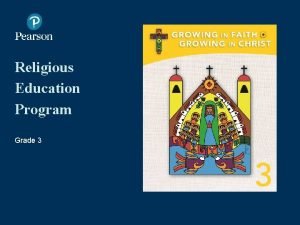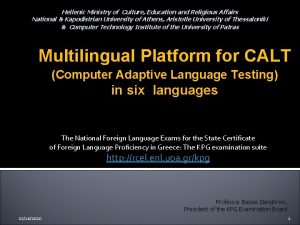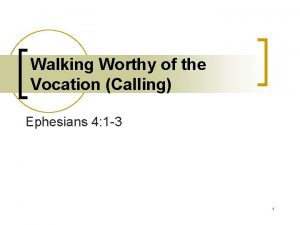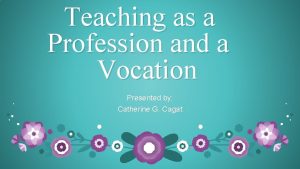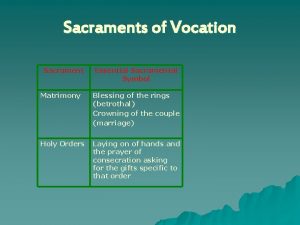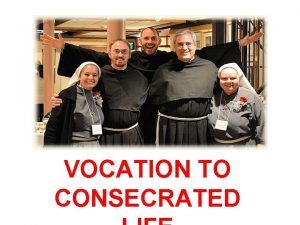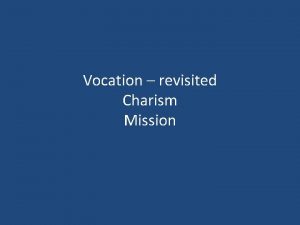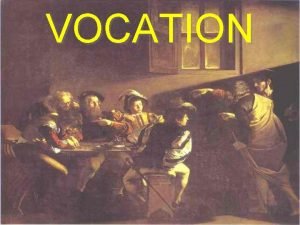RELIGIOUS EDUCATION Topic 1 Loving Topic 2 Vocation





- Slides: 5

RELIGIOUS EDUCATION: Topic 1 - Loving Topic 2 - Vocation & commitment Topic 3 - Expectations Topic 4 - Sources Topic 5 - Unity Topic 6 - Death & new life Topic 7 - Witnesses Topic 8 - Healing Topic 9 - Common good Judaism Islam Designated Safeguarding Lead – Mrs L Gamble Deputy Safeguarding Lead – Mrs P Martin Year 6 – Mr Rowe

AUTUMN TERM YEAR 6 Key texts/Reading Comprehension focus: Street Child by Berlie Doherty Are you listening? What is 27 plus 45? Come on! Faster now, we haven’t got all day! Find out about super-strict schools by travelling back in time to a Victorian classroom. Make sure you’re on your best behaviour though as punishments are unquestionably terrible! Discover a time when great minds thought new thoughts and ingenious inventors created the things we take for granted today: the lightbulb, the telephone and even the first flushing loo! Full steam ahead to the Victorian age… Rationale: During the topic ‘Revolution’ the children will discover when Victoria (Britain's second longest reigning monarch) lived and reigned, about her family and personal life as well as other key events in her life were and what she was like. They will then examine the vast expanse of the British Empire and challenge themselves to find countries and continents on a map as they discover which countries were part of the British Empire during the Victorian era as well as discover why Britain became the leader in trade and industry thanks to the Industrial Revolution. The children will identify inventions created during the Victorian era and explore some of the social and technological advances of the time and how they affected everyday life. During the second half term, the children will continue to look at key influences and discover the roles Dr Barnardo and Lord Shaftesbury played in looking at the laws and changes that were made during this period of time to protect children. This will then move on to looking at health and medicine. Help your child prepare… The Victorian era influenced the way we live now in many ways. Why not visit a local museum to learn about what Victorians’ lives were like in your area? You could also visit the library to find out about local Victorian history. Alternatively, make a collage timeline of key events in the Victorian period. Vocabulary: affluent boarding school butler descendent drill leisure factory invention British Empire power maid mill mine posser poverty Prince Albert Industrial Revolution Parliament population reform workhouse responsibility resilience

SPRING TERM YEAR 6 Key texts/Reading Comprehension focus: FROZEN KINGDOM Welcome to the planet’s coldest lands…vast wilds, hostile territories, incredibly beautiful yet often deadly. Take shelter from the elements or fall prey to icy winds and deepest chill. Trek bravely and valiantly across treacherous terrain to the ends of the Earth, treading deep in snow or pulled by a team of mighty sled dogs. Be alert, for magnificent mammals roam these lands, sometimes hungry or fresh for a fight. Perhaps a hungry polar bear or an artic fox: hunting rodents and swift as the wind. So wrap up well and settle by the fire. I’m going inside and may be sometime… Shackleton’s Journey by William Grill Rationale: Could you survive the planet’s coldest lands? Vast wilds, hostile territories, incredibly picturesque yet often deadly. Explore bravely and valiantly across dangerous terrain to the polar regions of the Earth, trekking deep in snow or pulled by a tram of mighty sled dogs. Make sure to watch out for the magnificent mammals that roam these lands: sometimes hungry or fresh for a fight. Research facts and figures of climate, temperature, habitats and eco-systems and discover what really happened to the Titanic. Become a member of an Antarctic rescue team so wrap up well everyone and settle by the fire. Help your child prepare… This term, we’re going to learn about the coldest places on Earth. Why not watch a documentary such as the BBC Frozen Planet series together? You could also freeze pieces of fruit with fruit juice in lolly moulds, to create frozen treats with a hidden surprise. Alternatively, work together to create a snowy collage. Vocabulary: Antarctic Auroua Borealis climate expedition explorer food chain glacier habitat iceberg ice sheet ice shelf icicle Inuit North Pole RMS Titanic seabed sea ice settlement snowstorm snow drift South Pole tundra

SUMMER TERM YEAR 6 Key texts/Reading Comprehension focus: Holes by Louis Sachar Welcome to Mexico! Get ready to Rationale: explore this unique country, from Bienvenido a Mexico! We’re going to explore this unique country, its towering temples and stunning from its towering temples to its fun-packed festivals. Using our geography to its pulsing rhythms literacy skills, we’ll write about festivals and create an invitation and fun-packed festivals. Tummy to a Mexican food tasting session. In preparation, we’ll make rumbling? Concoct a traditional delicious drinks and savoury dishes. We’ll learn about the ‘Day of fruit cocktail or delicious Mexican the Dead’ and create 3 -D skulls. We’ll read Maya myths and meal. Go steady with the spices! legends, and write our own. Using maps, we’ll locate Mexico and Feel like celebrating? Design a explore its natural features. We’ll discover what daily life is like flute, grab a drum, join a tribe and how it has changed over time. Then we’ll craft Maya and make some noise! Have you chocolate and simple woodwind instruments from recycled got what it takes to be a chief? materials. Who can make the highest, loudest and longest Let’s find out… sounds? Help your child prepare… Mexico is a fascinating land full of music and celebration. Why not work together and use non-fiction books or online research to find out about the impressive landmarks of Mexico? You could also look at holiday brochures or websites to plan an imaginary trip to Mexico. Alternatively, you could sample Mexican food in a restaurant or at home. Vocabulary: Mexico desert Day of the Dead Mayan temple Mayan glyphs stelae civilisation legend Uxmal Chichen Itza festival Chihuahua desert civilisation legend Tulum Mesoamerica hieroglyphics maize Palenque codex cacao vigesimal number system pok-ta-pok syllabogram

MATHEMATICS MASTERY AUTUMN Integers & Decimals Read, write, order and compare numbers to ten million. Apply a range of strategies for addition and subtraction to solve multi-step problems. Multiplication and division Multiply larger integers and decimal numbers with up to 2 decimal places using a range of strategies, including the formal written algorithms for long and short multiplication. Divide integers by 1 -digit and 2 -digit numbers using a range of strategies, representing remainders appropriately. Calculation problems Apply a range of strategies to solve multi-step problems, considering the agreed order of operations. Express missing number problems algebraically and solve equations with unknown values. Fractions 1 Deepen understanding of equivalence, in order to simplify, compare and order fractions, including those greater than one. Add and subtract fractions. Missing angles and lengths Compare and classify a range of geometric shapes, using angle facts to find unknown angles in triangles, quadrilaterals and regular polygons. MATHEMATICS MASTERY SPRING Coordinates and shape Describe positions on a full coordinate grid, exploring negative numbers in context. Apply an understanding of the properties of shapes to find missing coordinates and translate and reflect shapes. Recognise the properties of 3 D shapes and know the properties of circles. Fractions 2 Multiply and divide fractions. Deepen understanding of the links between fractions, multiplication and division. Decimals and measures Use, read, write and convert between standard units, including length, mass, volume and time. Calculate the area of shapes including parallelograms and triangles. Calculate the volume of cubes and cuboids. Percentages and statistics Recall equivalences between fractions, decimals and percentages. Solve problems involving the calculation of percentages. Interpret and construct pie and line graphs, and interpret the mean as an average. Proportion problems Solve problems involving unequal sharing, scale factor and the relative size of two quantities.
